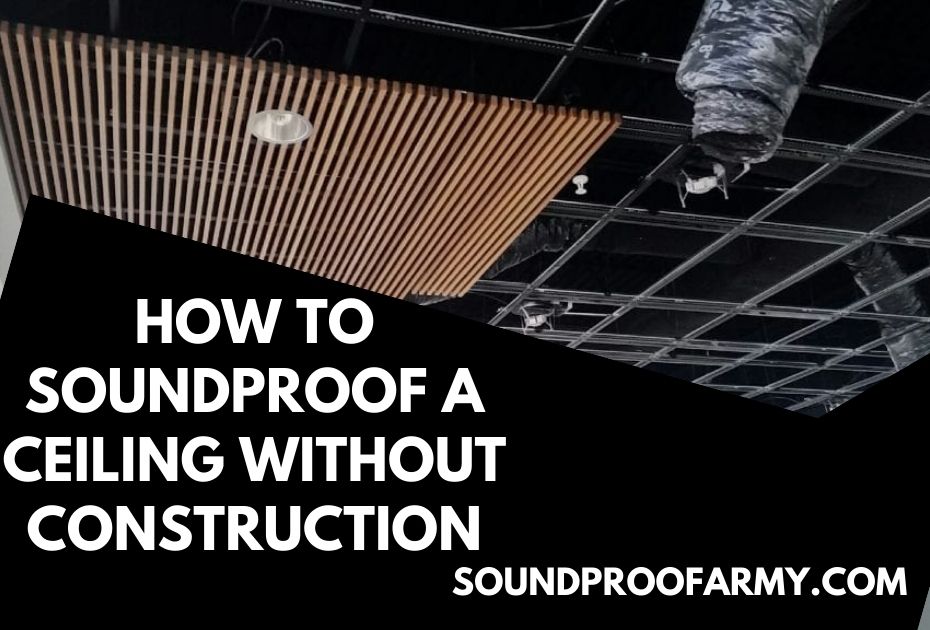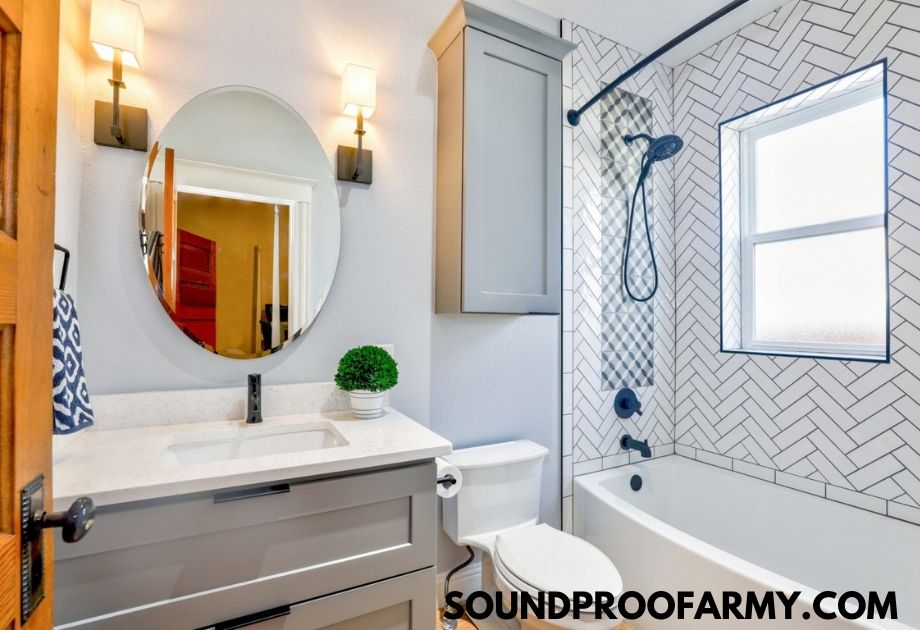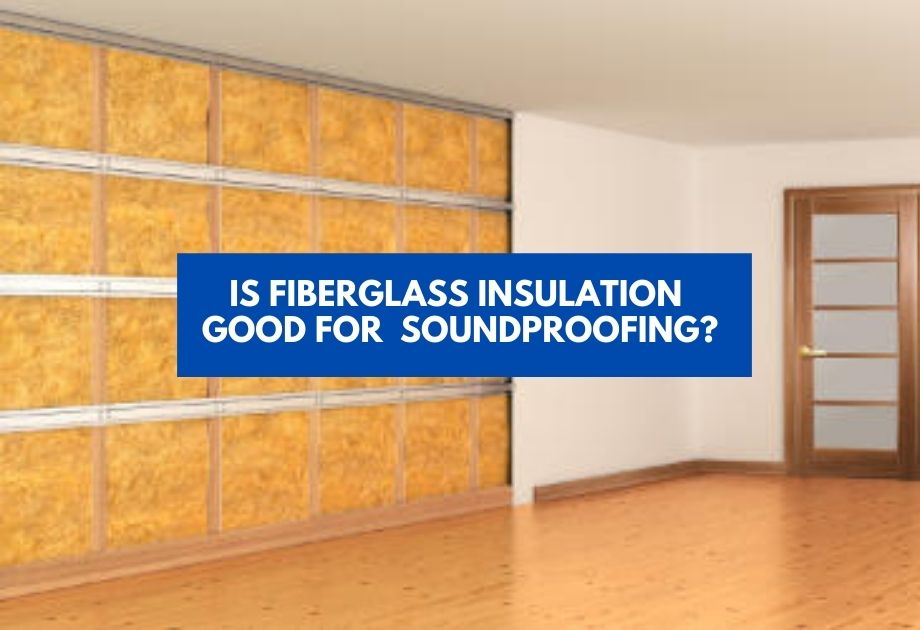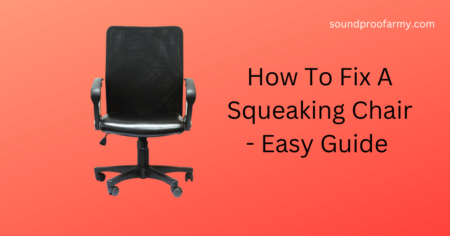Is sound leaking into your home from an upstairs neighbor? Or is sound coming through the ceiling and bothering you while you’re trying to watch tv in peace? But problem is how to soundproof a ceiling without construction?
You may have considered soundproofing a room by building a wall, but there are other ways.
Table of Contents
Soundproofing Ceiling Without Construction: 13 Easy Hacks
Get Rid of Air Leaks
Most people don’t realize that air leaks can be one of the most significant contributors as far as noise pollution goes. When it comes to minimizing noise, eliminating these gaps is key.
If you want to test for them yourself, find out where they exist with this simple test:
- Take two sheets of newspaper and put them on the ground, one above another.
- Walk around in your house’s attic looking for any gaps or cracks you can see by shining a flashlight into the ceiling area.
- If there is any light seeping through, it means that air is leaking out and noise will likely find its way inside with time as well.
Seal Wood Floors to Reduce Noise Pollution
Many homes use wooden floors which cause an amplified sound from walking across them – especially if they’re old! You may have heard this term before called “parquet flooring.”
This type of wood often has cores layered with thinner materials like veneer or plywood so some types of noise can penetrate the surface.
These sounds are usually loud enough to be heard by people in adjacent rooms or even next door!
So, if you have a parquet floor and want an easy way to soundproof your ceiling without building anything – this is it!
Use Carpeting for Sound Proof Ceiling Decorating
If you’re someone who loves their hardwood floors but also wants some type of carpeting on top of them, then install two layers of wood with thin mats/padding between each layer.
This will help cut down on any reverberation that may come from walking across the room as well as reducing outside noises coming through too much.
It’s also possible to use acoustic ceiling tiles which will help with soundproofing as well.
Use a Sound Absorber
These are typically made of foam and come in different shapes and sizes – so they can be customized for each specific need! This is also convenient because it’s portable, meaning that if you move out one day this won’t go to waste either.
You might even want to get some extra pieces just in case anything ever goes wrong too like getting damaged or lost during transit (e.g., moving).
Even if the problem so far has been with sound coming in, it may be that you are getting too much noise from outside sources.
Make Your Own Acoustic Foam Panels
Yes – making your own acoustic foam panels can be an option too! And not only will this help save money but also allow for DIY enthusiasts who want their ceilings decorated themselves to have some options available to them. To make these yourself, follow these directions:
- Take two pieces of wood and put them together. This should be done with a double-sided adhesive so that the wood doesn’t split apart later on or warp in any way.
- Then, take some acoustic foam and cut it into strips (or sheets) to stuff between these pieces of wood. To stabilize this placement, even more, use nails and hammer them through both layers – but avoid nailing too close to each other as they’ll curl up when you pull out your nail set afterward!
Install an Acoustic Tile Ceiling
If there are still parts of your home where noise pollution is prevalent then we recommend installing an acoustic tile ceiling which will help keep sound from coming inside at all.
These can also come in different shapes depending on the installation, but a great tip is to use any leftover tiles in the same room to help cover up any open spots! And if you really want soundproofing without building anything – this will be your best bet.
Use Mass Loaded Vinyl for Ceiling Soundproofing
Mass-loaded vinyl can be used for ceiling soundproofing. Mass-loaded vinyl supplies acoustic insulation, which effectively absorbs and diffuses sound waves that are reflected off the surface of the material.
The materials come as a fabric overlay draped onto your existing hardscape or dropped directly onto an open space in between joists or rafters, with cloth suspended from top to bottom.
Once installed this type of barrier helps keep noise out by reducing reverberation caused by footfall noises, voices, and other sounds throughout the area below it.
A layer of Drywall on Ceiling
A layer of drywall on the ceiling can help to soundproof a room. The sheetrock will block some noise from directly above and behind, but it’s not an ideal option for larger spaces or those with high ceilings.
Drywall is cheaper than other types of sound-blocking materials, which may be why it’s so popular for DIY projects. However, this type of installation should only be used in low traffic.
It’s a type of construction material made from gypsum plaster, sand, water, and other ingredients. It’s also called sheetrock in the U.S., or just plain old plasterboard if you’re in Australia.
It has been used for centuries as an interior surface to cover exposed walls areas such as offices and bedrooms because joints between sheets are often problematic when installing acoustic insulation panels that require a seamless surface to work effectively.
Use Acoustic Foam Egg Panels
Some homeowners may prefer to use acoustic foam egg panels as a soundproofing material for their ceilings.
These are usually made of polyurethane foam that is sandwiched in two pieces of fabric and easily hung on the ceiling with adhesives or screws.
The thickness and density can vary depending on how much noise reduction is desired, but they’re generally very lightweight and easy to install.
- This type of insulation typically comes pre-cut into squares or rectangles and many people buy them already taped together so there’s no need to measure anything out.
- They’re also inexpensive compared to other types because one panel will cover up a significant amount of area when installed correctly.
- There are some drawbacks though – these panels have a short-term lifespan (usually one year) and should be replaced if they start to deteriorate, or the soundproofing properties will decrease.
- This type of material is also not very easy for DIYers to install because it needs a lot of time and attention paid when measuring out each panel.
Use of Fiberglass Insulation
Fiberglass insulation is a type of material commonly used in the construction industry as an insulating layer.
This sound-deadening and fireproof product can be installed over your existing ceiling, which will help with noise reduction by lowering reverberation from sound waves.
In addition, you should look into installing flooring as well since this will reduce echo between floors while maintaining sound dampening properties throughout the house.
Additional Tips:
– Add carpet or linoleum on top of hardwood or tile floors if possible
– Install curtains around windows and doors where there are regular foot traffic to reduce noise pollution
– Install an air-duct system that leads outside of the home
Drywall With Resilient Channels
Resilient channels are basically metal strips that come in lengths of eight feet, and they can be cut down into pieces as needed for the application.
The baffles will typically need extra support from another type of material such as baseboard or crown molding placed next to them on top of framing members like wood beams.
After all this time spent reading about these types of materials I’m still not sure which to use; I’ll have to research them more and make a decision!
Mute X Soundproof Material
In today’s world of ever-increasing noise pollution, many people are looking for ways to lower the amount of sound in their environment.
One way is with a product called Mute X Soundproof Material, which reduces up to 96% of all airborne noise and 85% from impact noises.
It also has an extremely high energy absorbing value that reduces the amount of sound that can pass through an opening.
You might be wondering how this product is different from other products on the market, and it really just comes down to performance.
For example, Mute X Soundproof Material will reduce more noise than any other commercial-grade foam material because its perforated design creates a “honeycomb” effect that absorbs noise instead of reflecting it.
It has also been tested for durability by dropping weights onto it over 100 times without compromising its ability to absorb impact noises up to 85%.
This type of fabric eliminates airborne sound pollution as well, providing relief not only in open offices or large spaces but even in tight quarters like cars with windows rolled up!
Be a Good Neighbor/Stay Connected
The first part of soundproofing your ceiling is to be a good neighbor. If you are living upstairs, this means keeping loud noises down in the evening and at night so that those below can sleep without disruptions.
It also includes having windows open when it’s hot outside and being aware of any other noise sources like air conditioners or fans going on all day long.
This might include noisy kids running around inside or creating havoc with pets; water pipes banging against each other from an old building system; airplane traffic overhead; trains passing by every few minutes within earshot (even though they’re outside the house).
Noise can travel too! If you live on a busy street, then your windows need to be closed and sealed.
Also if you’re in a high-traffic area for planes or trains, it’s better not to have interior walls at all – just use exterior wall surfaces (or exterior insulation) without any space in between.
Final Thoughts On Soundproofing A Ceiling Without Construction:
No one knows for sure because it depends on you and your situation – but there are some general guidelines that apply:
– insulate well so heat doesn’t escape from upstairs or downstairs (depending on where you live) into the other areas of the house
– close doors between rooms and use curtains for windows to keep sound from traveling through your home.
– trim trees outside of your window to block noise
The list goes on, but it’s best if you start with these three tips because they don’t cost anything and will help a lot!
In addition, there are many situations in which your landowner will not allow you to do construction changes in the house.
So, you should go for the above-mentioned Tips and Types of soundproof ceilings.






![How To Soundproof A Basement Ceiling Cheaply [9 Ways]](https://soundproofarmy.com/wp-content/uploads/2021/06/cheapest-ways-to-soundproof-basement-ceiling-Simple-DIY-Hacks.jpg)
![How to Soundproof a Door with Household Items [14 Effective Ways]](https://soundproofarmy.com/wp-content/uploads/2021/07/How-to-Soundproof-a-Door-with-Household-Items.jpg)








